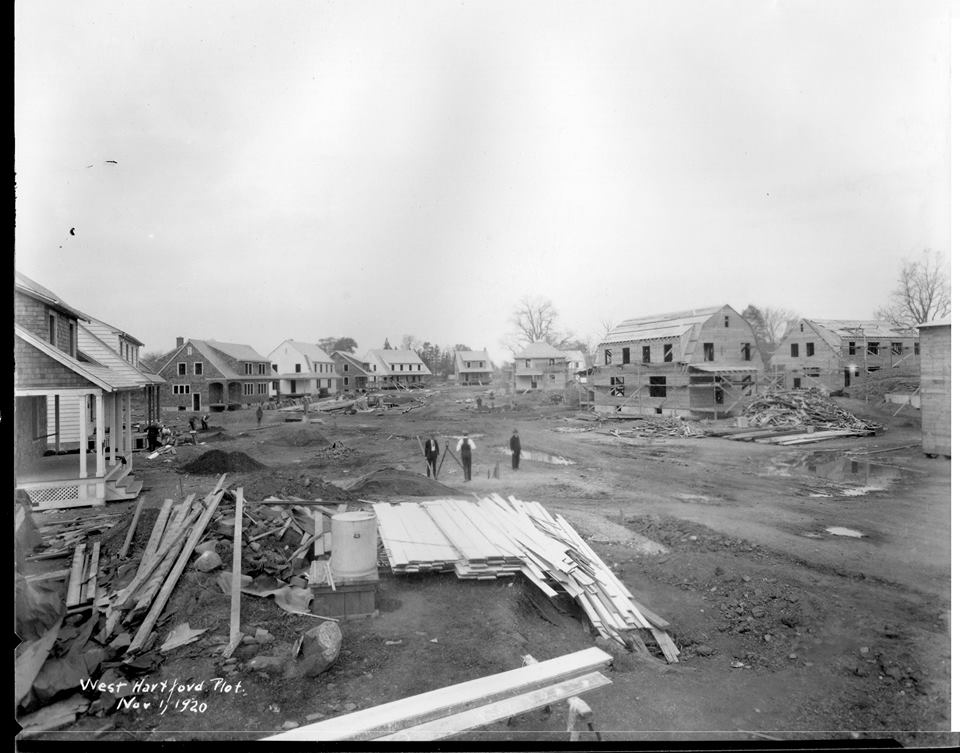From the West Hartford Archives: Washington Circle

Audio By Carbonatix

Washington Circle under construction, November 1920. Photo courtesy of Noah Webster House & West Hartford Historical Society
Historian Jeff Murray takes a look into West Hartford’s past to uncover some surprising information, stir up some memories, or reflect on how much life has changed – or hasn’t changed at all. Enjoy this week’s ‘From West Hartford’s Archives’ …
By Jeff Murray
Washington Circle emerged from the economic crises after World War I and was the creation of the Hartford Home Building Association, a group formed in the beginning of 1920. The insurance companies in Hartford, including Hartford Fire and Travelers, contributed tens of thousands of dollars to the fund.
After World War I ended in 1918, there was a major housing shortage in many American cities. The war effort had slowed or altogether stopped most domestic construction, leading to a backlog of demand from veterans and the return to normal life. Suburbs like West Hartford were already seeing population growth, so a section of land just over the city line and off Park Road, complete with trolley, was perfect for large-scale construction. Building associations like this one were popular in pooling resources to fund home construction.
Local companies, like the insurance empires in Hartford, encouraged the formation of these associations in conjunction with the city’s chamber of commerce. Federal government programs would become more present in future decades, but these were local initiatives.
A few months after the end of World War I, the Hartford Chamber of Commerce leveraged the housing committee to report on conditions in the city. By the summer of 1919, the committee was reporting that building restrictions during the war had been extremely painful and recovery was slow.
The housing shortage had reached a critical level. The construction industry faced labor strikes and severe material shortages. Inflation was on the rise and affordable housing was a persistent concern. Large numbers of Black residents were coming to Hartford from the rural South in the Great Migration, seeking better economic opportunities and an escape from tightening Jim Crow laws. This migration significantly increased populations in cities like Chicago, Washington, D.C., and St. Louis, but Hartford was no stranger to this influx.
Several leading Black civic leaders in Hartford were invited to weigh in on the Hartford housing crisis. The consensus was that rents were too high and smaller and cheaper apartments were required to accommodate newer residents. Despite overt widespread in the city, Hartford’s relative inclusion of Black residents in the conversation is especially poignant – in more than 30 other cities, the summer of 1919 (the so-called Red Summer) featured white supremacist violence and race riots that killed hundreds in more than 30 cities. Competition over jobs and housing after the war led to widespread unrest across the United States.
The Chamber of Commerce’s housing committee was actually created to address housing accommodations for Black residents coming from the South in droves since at least 1917. By 1919, after witnessing the conditions after the war ended, the committee declared the scope was much wider. Housing would need to be built for 4,000 people in just a year.
A number of recommendations were made: Hartford would need to address profiteering, health issues, higher rents and evictions, and simply build more houses. To push the last point, a million-dollar housing corporation was proposed, resulting in the creation of the Hartford Home Building Association. In the words of the chairman of the committee in December 1919, “We have a problem that unless aggressively attacked, increased rents, serious labor unrest, and a retarding of the growth of our city will result. Every possible thing should be done to stimulate the building of homes … by the combined civil interests of this city.”
In addition to insurance companies, local factories, like Colt Firearms, Royal and Underwood Typewriters, Pratt & Whitney, Hartford Rubber Works, and the Hartford Machine Screw Company pledged $400,000 to the effort. By February 1920, $1.5 million had been pledged.
The officers of the new association immediately set off on their mission to build houses on a large scale across the region. They met with the contractors who had done it successfully in other states, like the massive construction in Long Island suburbs. Multi-family houses and apartments were preferred to maximize the scarcity and high price of building materials.

T. C. Desmond Company field office on Newington Ave in Hartford; West Hartford can be seen in the background. Photo courtesy of Noah Webster House & West Hartford Historical Society
The T. C. Desmond Company of New York got the contract for construction, making president Thomas S. Desmond essentially a household name overnight for those following the daily news. The company had started in 1914, working first as engineers on subways in New York and then entering the housing business after the war neared the end, gaining nearly 1,000 workers when he came to Hartford. Some of the first houses were built off Zion Street, Blue Hills Avenue, and New Britain Avenue, but our very own Washington Circle was one of these projects.
John Peter Lykke sold the tract of land on the north side of Park Road to the association in the spring of 1920 for $23,000. Lykke had bought nearly all of the land between Park Road and Boulevard east of South Quaker Lane from Frederick Rockwell (the originator of the Boulevard) in 1902 and built a number of houses in the area. He had immigrated to the U.S. from Denmark in 1887 and married his wife Marie, who had come from Germany. By the time they moved to West Hartford, she was raising four children under the age of 12.
In the fall of 1916, Lykke opened a dead-end street named Eldon Street, named after one of the lot owners, Eldon Bourn. This would become the eastern end of Washington Circle and his house would become one of the first on the street (152/154 Washington Circle). After they sold the land off to the Hartford Home Building Association, John and his wife Marie moved to Springfield, Massachusetts, where he died in 1951.

Map of Washington Circle during construction and before the name change, in 1920. Peter Street was most likely named after John Peter Lykke, who sold the land to the company
Construction began on Sept. 1, 1920 with an overall plan for 45 houses on two streets named Peter Street (most likely named after John Peter Lykke, who sold the land) and the connection through Eldon Street. Foundations were completed in a few weeks. The featured photograph was taken in early November, which is made clear by the progress being made. The housing association hit a major snag though that month when financial distress forced the superior court to appoint a receiver to manage the funding and monitor the progress of the work. As a reflection of the economy of the day, the cost to build a single house was severely underestimated (the actual cost nearly double the estimate). The company was hemorrhaging money with each unit built.
Charles C. Cook, a West Hartford resident, builder, and former State Senator, was appointed receiver of the association and instructed to borrow $700,000 to complete the house building plan, including the 45 still under construction in West Hartford, many of them two-family houses. Work was finally completed in February 1921 under the oversight of David S. Douglass and the following month, Cook requested from the town a change of the names of the streets – Peter Street and Eldon Street would become Washington Circle.
On May 2, 1921, Cook sold all of the real estate (over 200 houses) to L. Edmund Zacher, treasurer of the Travelers Insurance Company, representing all the other big insurance companies. They formed a new association to oversee the completion of the work and by the summer of 1921, most of the Washington Circle houses were bought and occupied by employees of Travelers or Aetna.
Residents almost immediately had complaints that they were being required to send their children to the Seymour Avenue School (Smith School) rather than the East School at Whiting Lane. They wanted their children to avoid crossing the Park Road traffic, including the trolley, but the town argued there was no capacity. Schools were already overcrowded and Plant Junior High School was still under construction.
Washington Circle quickly took on a community of its own, with neighborhood events in the fall of 1921. A welfare organization was formed soon after, largely connected with Travelers and Aetna. Newly-built garages became meeting rooms for the street’s improvement association. Town employees lived on Washington Circle, including the clerk and fire district committee members.
Sometimes, the closeness was the source of tension. In June 1922, half-owners of one of the houses duked it out in public. John Nolan, treasurer of the Hartford Machine Screw Company, and Kurt Herold, manager of the National City Company’s local office, had been arguing for nearly half a year when Nolan drove his car across Herold’s lawn and the situation broke out in violence, with Herold breaking Nolan’s leg out in the yard.
Other times, commotion on Park Road threatened residents. A fire at A. C. Petersen’s garage and storehouse in 1924 endangered Washington Circle residents behind the buildings. Further development on Washington Circle, which was limited, was driven by the expansion of A. C. Petersen Farms on Park Road. The original pair of three-family houses on Park Road since the 1910s were moved to Washington Circle in 1939 when the new office and ice cream parlor were built. These homes are now at 149/151 and 143/145 Washington Circle, immediately behind the complex at the curve of the road.
The development of Washington Circle was a product of economic turmoil and local collaboration. West Hartford and Hartford made plenty of mistakes in the postwar years (and in many cases, they were simply winging it), but the willingness of every sector of society to coalesce around a common goal is undeniable. The demand for housing during a nationwide shortage pushed the broader community to find a solution, even if it meant that everyday people were chipping in. The association faced significant financial challenges, including escalating material costs, rampant fear of labor strikes, and unanticipated construction expenses, but the project was completed successfully and West Hartford enjoyed the increase in the tax base and traffic to Park Road businesses.
Challenges would continue, including the overcrowding of the 1950s and the lack of public parks into the 1960s, but Washington Circle remains a case study of how cities and their suburbs managed both massive growth and economic stagnation towards a stable postwar recovery.

Washington Circle, Google Street view July 2024
Jeff Murray was born and raised in West Hartford and has been involved with the Noah Webster House & West Hartford Historical Society since 2011 when he was a high school student and won the Meyer Prize for his essay on local history. Jeff routinely volunteers as local history researcher uncovering information for numerous museum programs such as the West Hartford House Tour and West Hartford Hauntings. Jeff works as a data analyst at Pratt & Whitney.
Like what you see here? Click here to subscribe to We-Ha’s newsletter so you’ll always be in the know about what’s happening in West Hartford! Click the blue button below to become a supporter of We-Ha.com and our efforts to continue producing quality journalism.



